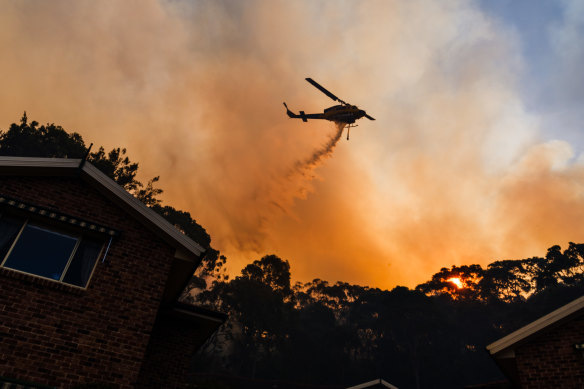By Angus Thomson
Efforts to control a hazard reduction burn that quickly burst containment lines on Sydney’s northern beaches will continue on Sunday as fire crews race against time to reduce fuel in suburbs that have not burnt in decades.
The NSW Rural Fire Service issued an emergency warning on Saturday afternoon regarding a blaze on Meatworks Avenue at Oxford Falls, telling some residents in the Cromer Heights area it was too late to leave. The fire began as a planned burn but reached 100 hectares by 8pm, when the fire service said conditions had eased and the blaze was “being controlled”.

The bushfire behind a retirement home in Cromer Heights, on Sydney’s northern beaches. Credit: James Brickwood
The fire had burnt 139 hectares by Sunday afternoon. RFS spokesman Inspector Ben Shepherd said crews were strengthening control lines on Sunday and may have to light further backburns on the fire’s western edge, where there are some pockets of bush at risk of lighting up.
“If they introduce those burns, which they likely will within the coming hours, that is going to increase the amount of smoke and possible visible fire to people,” Shepherd said. “I’m not anticipating at this stage any further threats to homes.”
Meanwhile, in Sydney’s east, NSW Fire and Rescue have brought a five-hectare scrub fire on the Malabar headland under control, after police told walkers to avoid the area.
Wet conditions meant the RFS completed 43 per cent of its 325,000-hectare hazard reduction target last financial year.
Shepherd said the service had prioritised reducing fuel around homes and properties, and had burnt 70 per cent of its hazard reduction target in those areas. Crews were targeting the area where the blaze eventually escaped, Shepherd said, because it had not burnt for 30 years.
“No one would be eating themselves up more than the firefighters who were actually on scene yesterday trying to do that burn because they understand the importance of this work, and they understand the need to get it done,” he said. “It is a bit of a double-edged sword sometimes, but we are way behind on our hazard reduction plan after three incredibly wet years.”
Warmer temperatures through August and September had provided a window for burns to take place, but Shepherd said firefighters were not taking greater risks to catch up. “It is important that we get it done, but equally, we need to ensure that it’s been done safely,” he said.
Four smaller hazard reduction burns are planned for next week on the northern beaches, according to the RFS website. Burns are also planned near Castle Hill, Penrith and at locations in the Blue Mountains.
Emergency Services Minister Jihad Dib last week warned hot and dry conditions were expected this summer.
“After several years of rainfall and flooding the vegetation has grown quickly and that is now drying out with the warmer weather, adding to fire risk,” he said.
Get alerts on significant breaking news as happens. Sign up for our Breaking News Alert.